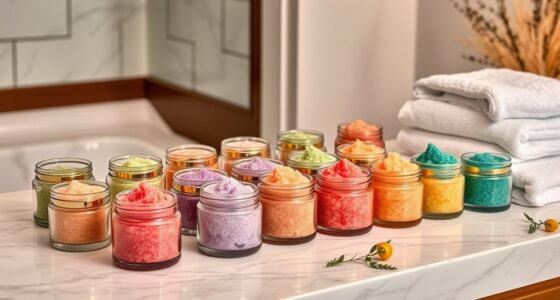Bamboo sheets are praised for their softness, breathability, and sustainability, making them feel luxurious and eco-friendly. They’re made from bamboo fibers processed into fabrics like rayon or lyocell, which require less water and pesticides than cotton, supporting a greener choice. However, some processing methods involve chemicals that can impact their eco-credentials. To see if bamboo sheets truly suit your needs and eco values, explore the details behind their production, sustainability, and performance benefits.
Key Takeaways
- Bamboo sheets are made from sustainably grown fibers, offering eco-friendly benefits due to low water and pesticide use.
- They provide superior breathability, moisture-wicking, and hypoallergenic properties, enhancing sleep comfort and skin health.
- Processing methods vary; chemical-intensive production can impact environmental claims, despite bamboo’s renewable reputation.
- While more expensive than cotton, bamboo sheets are durable, resistant to pilling, and considered a luxurious, long-lasting investment.
- Certifications like OEKO-TEX and FSC help verify their sustainability, but some view the trend as overstated without full transparency.
What Are Bamboo Sheets and How Are They Made?
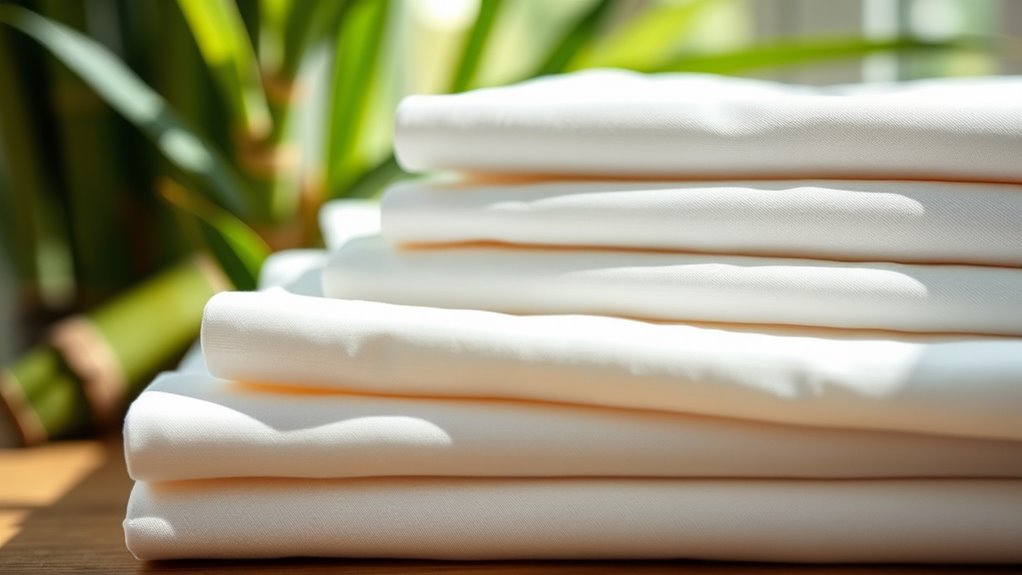
Bamboo sheets are made from fibers derived from the bamboo plant, which are processed into soft, silky fabrics like rayon, modal, or lyocell. The manufacturing process starts with natural bamboo being turned into bamboo pulp, which is then chemically transformed into bamboo fibers. These fibers are spun into bamboo fabric, resulting in smooth, breathable sheets. Although chemical processing is involved, bamboo sheets are considered eco-friendly because bamboo is a fast-growing, renewable resource that needs minimal water and pesticides. The type of fabric—rayon, modal, or lyocell—depends on the chemical treatment used during production. Despite the processing steps, choosing bamboo sheets can still be a sustainable option if produced with eco-conscious methods and certifications like OEKO-TEX. Additionally, advances in sustainable manufacturing are making bamboo textiles increasingly environmentally friendly. Moreover, the chemical processing involved can vary in environmental impact depending on the methods used by manufacturers. Incorporating environmentally conscious practices in manufacturing can further reduce the ecological footprint of bamboo textiles.
The Different Types of Bamboo Bed Sheets and Weaves

When choosing bamboo sheets, the type of weave can markedly influence their feel, look, and performance. Bamboo weaves include percale, sateen, and twill, each offering unique textures and qualities. Percale bamboo sheets are lightweight, crisp, highly breathable, and durable, making them perfect for hot sleepers. Sateen bamboo sheets have a silky, smooth finish, providing a luxurious feel, though they trap more heat, ideal for cooler nights. Twill bamboo sheets feature diagonal ribbing, increasing durability and warmth, with a denim-like appearance. The weave affects the texture of bamboo bedding, its breathability, wrinkle resistance, and overall performance. Whether you prefer the lightness of percale or the sumptuousness of sateen, selecting the right weave guarantees your bamboo sheets meet your comfort and durability needs. Additionally, understanding the fiber quality of bamboo sheets can help ensure longevity and eco-friendliness. Using high-quality fibers can also enhance the sustainability of your bedding choices, making them a more eco-friendly option. For those seeking a balance of softness and durability, the weave type plays a crucial role in determining how the sheets will feel over time. Moreover, the manufacturing process can influence the environmental impact and overall quality of bamboo bedding.
How Bamboo Sheets Compare to Traditional Cotton Sheets
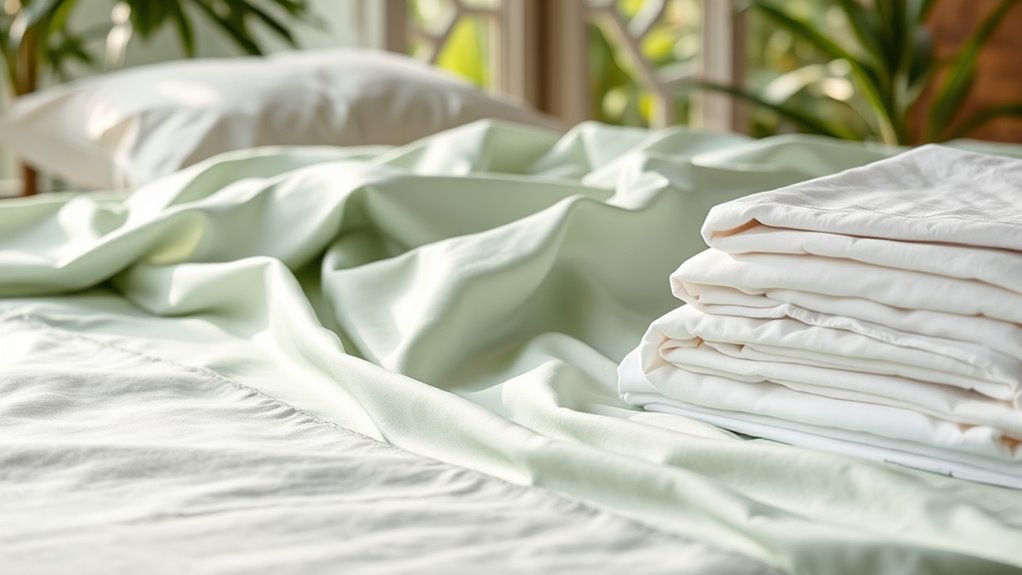
Compared to traditional cotton sheets, bamboo sheets often feel softer and silkier, even at lower thread counts, providing a luxurious touch without the high price. They excel in breathability and moisture-wicking, helping you stay cool and comfortable throughout the night—especially in hot weather. While high-quality cotton like Pima or Egyptian can be very soft, bamboo offers comparable luxury at a more affordable price point. As a natural fabric, bamboo sheets promote comfort and sustainability, requiring less water and pesticides than conventional cotton. Although some bamboo fabrics undergo chemical processing, sustainably sourced options tend to be more eco-friendly. Additionally, camping resources and guides highlight the importance of choosing eco-conscious materials, making bamboo sheets a fitting choice for environmentally aware consumers. Incorporating creative practice into your daily routine can also foster mindfulness and appreciation for sustainable living. Understanding the environmental impact of fabrics can help consumers make more informed choices about their bedding. Recent advancements in fabric manufacturing have also improved the eco-friendly qualities of bamboo textiles, making them even more sustainable. Overall, bamboo sheets combine softness, breathability, and eco-consciousness, making them a compelling alternative to traditional cotton bed sheets. Additionally, hostings and VPS services often offer discounts and promo codes, making it easier to invest in eco-friendly and comfortable bedding options.
Are Bamboo Sheets Truly Eco-Friendly? Examining Sustainability
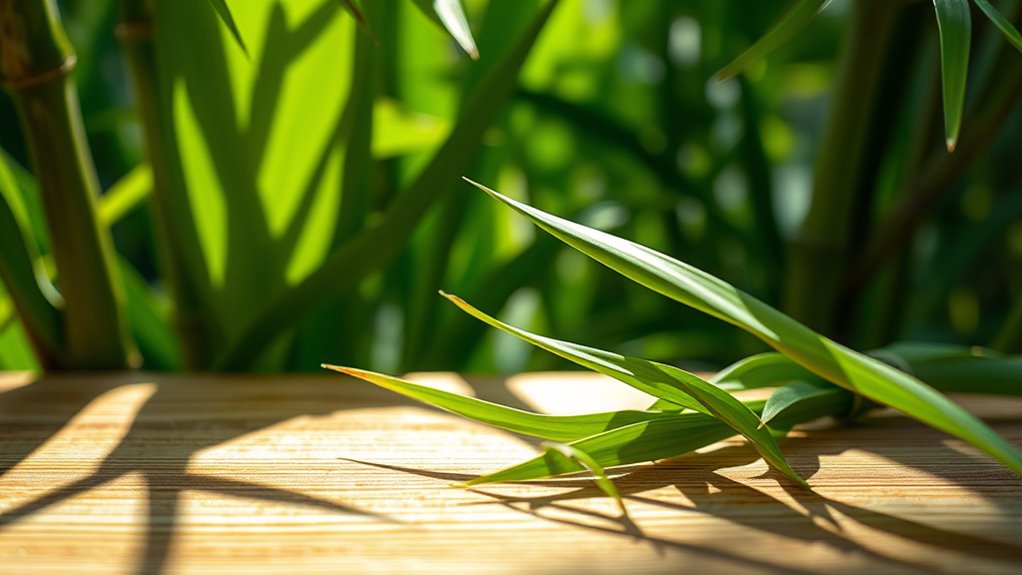
Bamboo grows quickly with minimal water, making it a more sustainable resource than cotton. However, the chemical processing needed for fabric can raise environmental concerns, even if the plant itself is eco-friendly. Look for certified bamboo products to guarantee you’re choosing options that prioritize sustainability and safe manufacturing practices. Additionally, the automation in manufacturing of bamboo textiles can influence the environmental impact of production processes. It is also important to consider the nutritional value of juices involved in some bamboo processing methods, which can impact the overall eco-friendliness of the product.
Rapid Growth Benefits
Have you ever wondered why bamboo is considered such an eco-friendly resource? Its rapid growth allows it to reach full size in just 3-5 years, making it a highly renewable resource. This fast-growing plant supports sustainable harvesting because it regenerates from its roots without replanting. Plus, bamboo requires low water and no pesticides or fertilizers, reducing environmental impact. Although chemical processing is involved in turning bamboo into fabric, its quick growth and responsible cultivation strengthen its reputation as an eco-conscious raw material.
- Bamboo’s rapid growth supports sustainable harvesting with a short growth cycle
- Low water requirements and no need for chemical fertilizers make it environmentally friendly
- Its status as a fast-growing plant enhances its role as a sustainable resource
Water and Chemical Use
While bamboo is often praised for its low water requirements, the sustainability of bamboo sheets also depends heavily on how the fibers are processed. Chemical processing of bamboo pulp into viscose or rayon involves substances like sulfuric acid and carbon disulfide, which can pose environmental and health risks if not managed properly. Although bamboo naturally grows quickly and resists pests, its environmental impact is affected by chemical treatments used during fiber conversion. Chemical alternatives, such as lyocell, offer more eco-friendly production options but are less common and pricier. Not all bamboo sheets are equally sustainable—look for certifications like OEKO-TEX or FSC to ensure reduced chemical use and better environmental practices. Additionally, understanding the Relationships – Personality Test can help consumers make more informed and mindful choices about eco-friendly products. Moreover, sustainable manufacturing practices play a crucial role in determining the overall environmental impact of bamboo products. For instance, the water footprint of bamboo cultivation is generally low, but the entire lifecycle impact must be considered to gauge true sustainability.
Certification and Sourcing
Are bamboo sheets truly eco-friendly, or does their sustainability depend on more than just the plant itself? Certifications like OEKO-TEX and FSC guarantee that bamboo is sourced responsibly and meets strict environmental standards. These labels indicate that sustainable sourcing and eco-conscious practices are in place, promoting responsible management of bamboo forests. However, the chemical processing involved in turning bamboo into fabric can influence its eco-friendly status, depending on manufacturing practices. To truly assess sustainability, look for certifications that verify environmentally friendly and responsible management practices. Additionally, processing methods play a significant role in determining the overall eco-friendliness of bamboo sheets, as they can impact chemical usage and environmental footprint. The choice of manufacturing techniques can also affect the durability and environmental impact of the final product.
The Benefits of Bamboo Sheets for Skin and Allergies
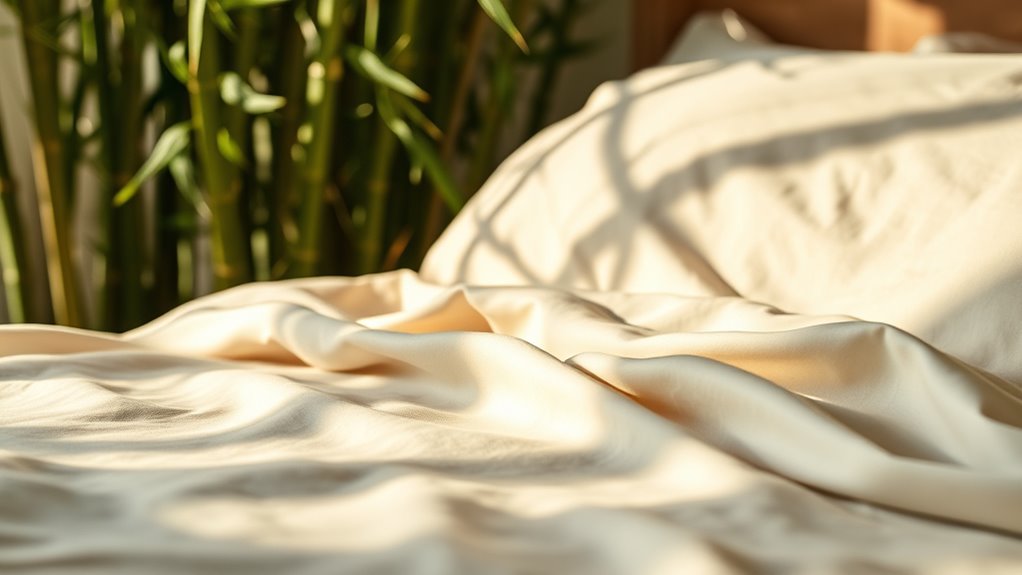
Bamboo sheets offer significant benefits for your skin and allergy concerns because of their natural hypoallergenic and antimicrobial properties. They help reduce skin irritation and allergic reactions, making them ideal for sensitive skin. Their antimicrobial properties inhibit bacteria, fungi, and dust mites, creating a cleaner sleep environment. The moisture-wicking ability keeps your skin dry, preventing irritation caused by sweat. Bamboo fibers are breathable and soothing, perfect for conditions like eczema or dermatitis. Plus, their chemical-free production ensures you’re avoiding harmful chemicals. Here’s a quick comparison:
| Benefit | How It Helps | Key Feature |
|---|---|---|
| Hypoallergenic | Reduces allergic reactions | Natural, chemical-free |
| Antimicrobial | Stops bacteria, fungi, dust mites | Keeps bedding cleaner |
| Moisture-wicking | Prevents skin irritation from sweat | Keeps skin dry |
| Breathable & Soothing | Comfort for sensitive skin | Gentle, calming fibers |
How Do Bamboo Sheets Perform in Hot Weather?
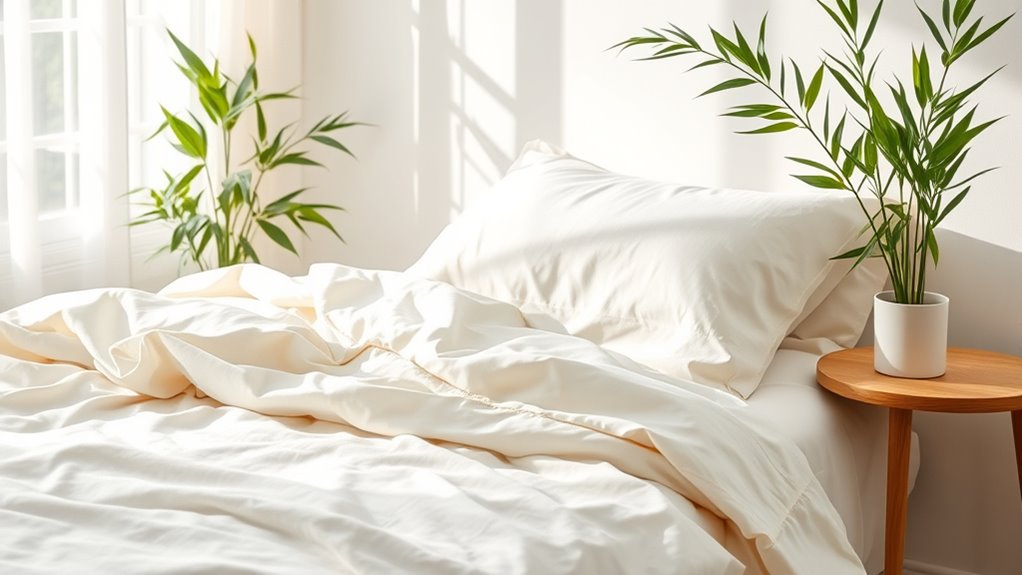
Ever wondered why bamboo sheets are a popular choice for hot weather? Their natural breathability and lightweight design promote better air circulation, helping with heat dissipation and thermal regulation. These sheets excel in maintaining a cooler sleep environment by preventing heat from building up. Their moisture-wicking and sweat absorption properties draw moisture away from your skin, keeping you dry and comfortable throughout the night. Thanks to their cooling properties, bamboo sheets help reduce overheating, especially in hot climates or summer months. Their ability to regulate temperature makes them ideal for staying cool during warm nights.
- Superior breathability and air circulation
- Effective moisture-wicking and sweat absorption
- Lightweight weave for better heat dissipation
Caring for Bamboo Sheets: Maintenance and Longevity
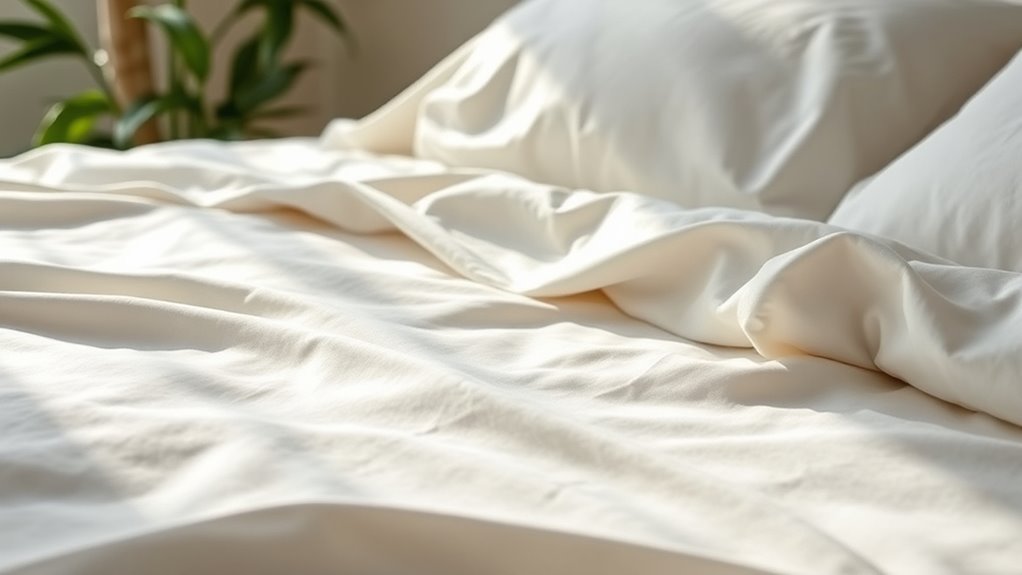
To keep your bamboo sheets in great shape, pay attention to proper washing and drying techniques. Using cold water and a gentle cycle helps maintain their softness and fibers, while line drying or low-heat tumble drying prevents shrinking. Following these tips ensures your sheets stay comfortable and last longer.
Washing Tips and Tricks
Properly washing your bamboo sheets is essential to keep them soft, durable, and looking their best. Use a cold water wash on a gentle cycle to protect the fibers and prevent damage. Avoid harsh detergents, bleach, and fabric softeners, as these can weaken fabric integrity and reduce longevity. Always follow the care instructions on the label for best results. To maintain durability and prevent shrinkage, line dry in the shade or tumble dry on low heat. Regular washing removes dirt, oils, and bacteria, keeping your sheets fresh and antimicrobial. Proper care guarantees your bamboo sheets stay comfortable and last longer, making investment worthwhile.
- Wash in cold water on a gentle cycle
- Avoid bleach and fabric softeners
- Dry on low heat or line dry
Proper Drying Techniques
Drying bamboo sheets correctly is key to maintaining their softness and lifespan. To do this, line dry them in the shade to prevent sun damage and preserve color vibrancy. If you prefer using a dryer, choose a low heat or delicate setting to avoid shrinkage and fabric damage. High heat and prolonged drying cycles can weaken bamboo fibers, reducing the sheets’ durability. To minimize wrinkles, remove the sheets promptly from the dryer and fold or hang them immediately. Avoid sun damage by drying in a shaded area, and steer clear of high heat that can harm fabric fibers. Proper drying techniques ensure your bamboo sheets stay soft, vibrant, and long-lasting, protecting your investment and enhancing your sleep experience.
Common Myths and Misconceptions About Bamboo Bedding
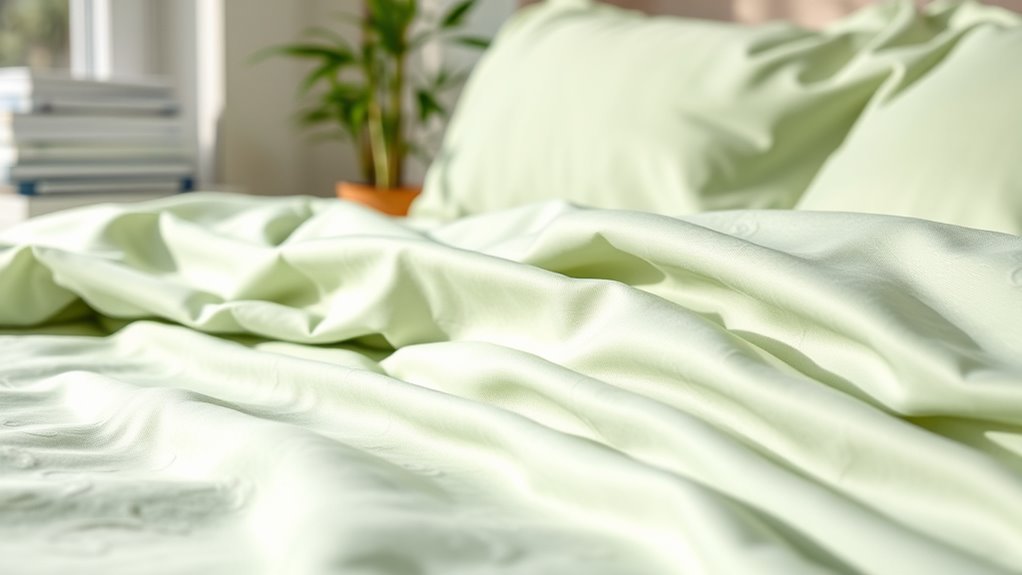
Many people assume that all bamboo sheets are entirely eco-friendly and naturally superior to other fabrics, but the reality is more complex. The myths and misconceptions about bamboo bedding often overlook the chemical processing involved in producing bamboo viscose, which can reduce its sustainability. Not all bamboo sheets are equally soft or durable—manufacturing quality and weave type matter. Additionally, the idea that bamboo is completely hypoallergenic isn’t always accurate, especially if chemicals are used. Some antimicrobial claims are overstated, as these properties can fade after washing or depend on specific processing methods. Ultimately, bamboo sheets can wrinkle like other natural fibers, particularly if made from sateen or blends.
Bamboo sheets’ eco-friendliness and hypoallergenic claims vary with processing, quality, and weave type.
- Chemical processing impacts eco-friendliness
- Manufacturing quality determines softness and durability
- Hypoallergenic and antimicrobial claims vary
Are Bamboo Sheets Better Than Other Sustainable Alternatives?

When comparing bamboo sheets to other sustainable fabrics like Tencel or hemp, bamboo often stands out for its silky softness, moisture-wicking abilities, and rapid growth. As a sustainable bedding choice, bamboo boasts natural properties that promote breathability and temperature regulation, keeping you comfortable all night. While some concerns exist about chemical processing, certified organic bamboo offers a greener option with fewer environmental impacts. Bamboo sheets are also hypoallergenic, making them ideal for sensitive skin. Compared to other eco-friendly fabrics, bamboo provides a durable, luxurious feel that surpasses many alternatives. Although they tend to cost more, their natural properties and eco-friendly options make bamboo sheets a compelling choice for those seeking both comfort and sustainability in their bedding.
Is the Price of Bamboo Sheets Justified by Their Benefits?
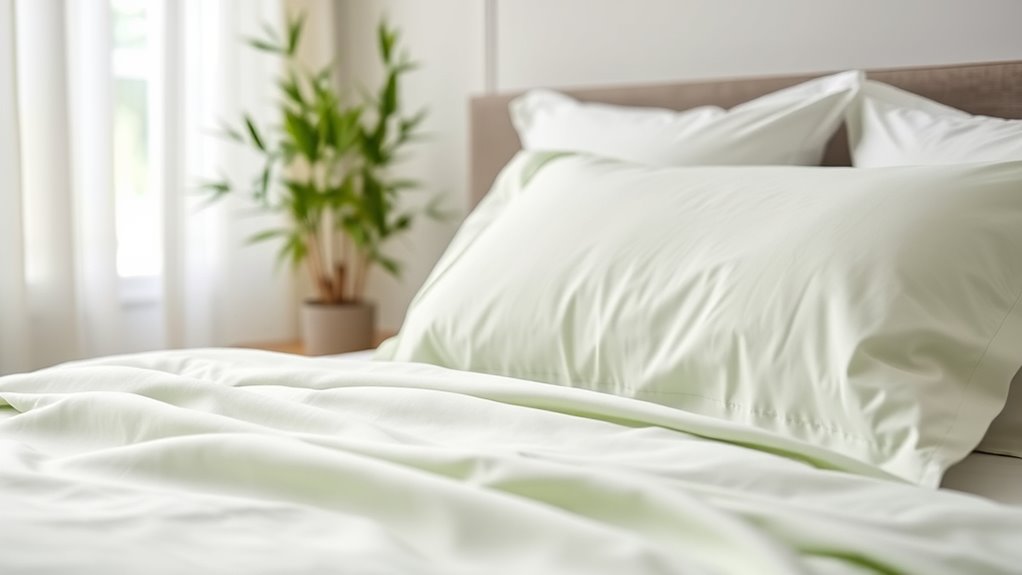
Is the higher cost of bamboo sheets truly justified by their benefits? Many find that the price justified by the benefits of bamboo bedding. These sheets offer durability, softness, and eco-friendly manufacturing, making them a smart investment. Their long-lasting nature and resistance to pilling can save you money over time, offsetting the initial cost. Certification labels like OEKO-TEX ensure quality sheets produced sustainably, adding value. The moisture-wicking properties and temperature regulation enhance sleep comfort, which many health-conscious consumers appreciate. While they cost more than traditional cotton sheets, bamboo sheets provide a luxurious, hypoallergenic experience that supports eco-conscious living.
- Long-lasting and resistant to pilling
- Superior moisture-wicking and temperature regulation
- Eco-friendly manufacturing with quality certifications
Frequently Asked Questions
What Is the Downside to Bamboo Sheets?
You might find bamboo sheets have some downsides. They often involve chemical processing with toxic substances, which harms the environment and health. Some sheets are blended with synthetic fibers, reducing breathability and antimicrobial benefits. Lower-quality options tend to pill and lose softness quickly. Plus, if not made sustainably, bamboo sheets can diminish their eco-friendly appeal, especially when mixed with non-biodegradable materials or chemically treated.
What Is the Downside of Bamboo Fabric?
Like Pandora’s box, bamboo fabric hides some risks. You might find it’s processed with toxic chemicals, which can harm the environment and your health. When blended with synthetics, it loses some of its eco-friendly edge, and low-quality options tend to pill easily. Harsh treatments can also strip away bamboo’s natural hypoallergenic benefits. So, while bamboo seems green, be aware of these hidden downsides before you buy.
Are Bamboo Sheets Environmentally Friendly?
You’re wondering if bamboo sheets are truly eco-friendly. While bamboo grows quickly and needs minimal water, the manufacturing process often involves chemical treatments that can harm the environment. Certified sources help guarantee responsible harvesting, but the overall eco-friendliness depends on how the fibers are processed. If the materials are natural and minimally treated, your bamboo sheets can be a sustainable choice. However, heavily processed or blended fabrics may lessen those benefits.
What Happens if You Put Bamboo Sheets in the Dryer?
Think of your bamboo sheets as delicate dancers. If you throw them into a hot dryer, you’re forcing them to perform under harsh lights, which weakens their fibers and causes pilling. High heat can also make them shrink, ruining their fit. To keep them graceful and soft, dry on low heat or air-dry, removing promptly to preserve their gentle touch and longevity.
Conclusion
Think of bamboo sheets as a lush garden—beautiful and eco-friendly if you tend to it carefully. But just like any garden, they need proper care and understanding to truly flourish. Don’t be fooled by the surface; dig deeper into their benefits and myths. When you make informed choices, you’re planting seeds for comfort and sustainability that can grow into long-lasting, eco-conscious habits. Your bed—and the planet—will thank you.



